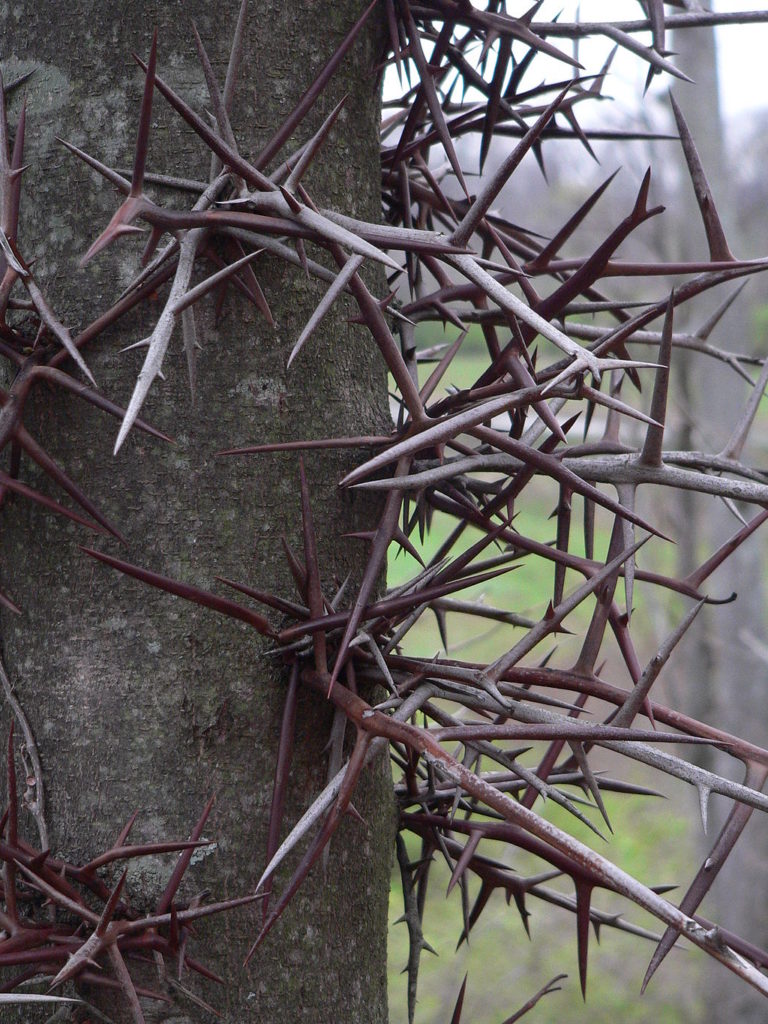I’ve written previously about my endeavors to grow honey locust seedlings in an air-prune bed, and initially, this was just a proof of concept for my air-prune beds, which were built to house hazelnuts, chestnuts, and various fruit tree seedlings. Recently though, my research has lead me to realize just how valuable these trees are for hunters and graziers (farmers who manage grazing animals).
Honey Locust is a tree that’s often spoken of with disdain–and there’s some reason for that. There are varieties that grow massive compound thorns (that’s thorns that grow thorns on their sides) that can literally kill a man, being as large as 8 inches long. Additionally, their ability to fix nitrogen means they grow aggressively. Many a poor farmer has bled trying to fight back this beastly tree!
The key to my affections for this tree are all in the genetics–there are trees that are bred to be allies rather than adversaries for hunters and farmers alike.

By Greg Hume – Own work, CC BY-SA 3.0, https://commons.wikimedia.org/w/index.php?curid=17878744
What are good genetics, and how did we get them?
It’s worth your time to learn about John Hershey. Not the Chocolate one. Not the politician either. I guess it’s a common name in Pennsylvania. The John Hershey I’m talking about was a forward-thinking agriculturalist who deeply loved trees. Hershey held contests where farmers could bring their best trees and win prizes for them. Naturally, this made Hershey’s estate a home to some of the best tree genetics that exist in the Northeast.
Hershey was an inspiration to J. Russell Smith, whose seminal work Tree Crops: A Permanent Agriculture (listed on our sources page) drew heavily from Hershey’s craft. Similarly, Bill Mollison drew inspiration from J. Russell Smith’s book, and termed his body of work “Permaculture,” a portmanteau of “Permanent Agriculture.” The Roots of a Global Movement are in our backyard! But I digress.
John Hershey’s contests to develop the best tree genetics, for honey locusts, resulted in trees that were thornless and with robust pod production.
thornless
You’ve seen the thorns on honey locust (scroll up for a refresher, tiktok generation). Obviously, thorns like this are not conducive to easy management. This one kinda explains itself, but all the best cultivar honey locust are thornless.
robust pod production
After like 16,000 paragraphs of introduction as to why I’m wetting my pants about these trees (sorry), here’s the skinny. Honey Locust trees drop a highly nutritious and calorie dense pod in absolutely staggering volumes, dependably, every year. Honey Locust pods are useful as a late fall and winter forage for deer, pigs, cows, horses, and other animals we like. Their pods drop and feed animals in a time when grass forages are scarce, non-existent, or dormant. They do all this work without any human intervention after planting, and are extremely vigorous and hardy. They tolerate abuse and neglect.
When combined with other soft mast (fruit) trees like persimmons, apples, and mulberries, plus hard masts like chestnuts, a well thought-out multispecies orchard can provide rich abundance to grazing and foraging animals.
Possibilities abound for silvopasture with a multispecies orchard:
Chickens can be fed with grown-on-site antioxidant rich fruit and seed.
Deer can be attracted and maintained on a property of moderate acreage–protecting the farmer-next-door’s crops while providing a simple, easy hunt on animals that have been well-fed and cared for.
Graziers can reduce or eliminate the need for imported hay with these species in conjunction with leaf hay species like willow and poplar.
Nitrogen fixing species like siberian pea shrub, locust trees, and seaberry/seabuckthorn organically improve the soil around them without need for external imports.
Farmers can enjoy and additional cropping layer, whether that be a harvest of fruit, nuts, or wood.
conclusion
If you’ve read this far, you’re probably at least getting a little bit excited with me, and I think that’s fantastic. Furthermore, if you want to read about how I started my honey locust seedlings, check out this air prune bed tutorial video, or review my strategy for encouraging germination in honey locust.
You can get email notifications when I post new content, it’s super easy to just drop your name (or a humorous pseudonym, the dutiful email robot will be amused by your whimsy no doubt) and your email into the handy little boxes below. The ONLY emails you’ll get are new content notifications. I will not spam you because I have nothing to sell to you.
Leave a Reply